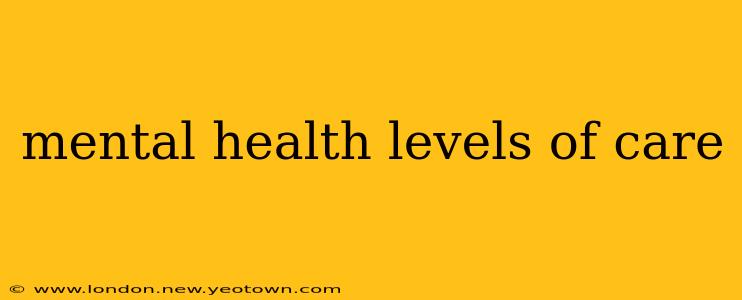Mental health is a journey, not a destination. Sometimes, the path is smooth, and we sail along effortlessly. Other times, we encounter rough seas requiring specialized support. Understanding the different levels of mental healthcare is crucial to navigating these challenges effectively. This isn't just about finding the right treatment; it's about finding the right level of care tailored to your specific needs at that moment.
Think of it like this: a mild headache might be solved with over-the-counter pain relief. A severe migraine, however, requires a doctor's visit, perhaps even specialized medication. Mental health works similarly. Different levels of care address different intensities of need.
What are the Different Levels of Mental Healthcare?
The levels of care aren't always rigidly defined, and the terminology can vary depending on location and provider. However, a common framework includes:
-
Self-Help and Peer Support: This is the first level and often the most accessible. It involves strategies you can employ independently, such as mindfulness exercises, journaling, healthy lifestyle choices, and connecting with supportive friends and family. Peer support groups provide a safe space to share experiences and learn coping mechanisms from others facing similar challenges. Think of it as the "over-the-counter" approach to mental health.
-
Outpatient Care: This level involves regular appointments with a mental health professional, such as a therapist, psychiatrist, or counselor, in an office setting. It's suitable for individuals who are managing their mental health well enough to function independently but require ongoing support and guidance. This could involve therapy, medication management, or a combination of both.
-
Intensive Outpatient Programs (IOPs): These programs offer a higher level of structured care than traditional outpatient therapy. IOPs typically involve multiple therapy sessions per week, often focusing on specific issues or disorders. They provide more intensive support than standard outpatient treatment but still allow individuals to maintain their daily routines.
-
Partial Hospitalization Programs (PHPs): PHPs offer a step up from IOPs, providing more intensive care for those who require a structured environment but don't need 24-hour hospitalization. Individuals attend the program for several hours each day, participating in group and individual therapy, medication management, and other activities aimed at stabilizing their mental health.
-
Inpatient Hospitalization: This is the highest level of care, reserved for individuals experiencing severe mental health crises that require 24-hour supervision and intensive treatment. Hospitalization may be necessary when there's an immediate risk of harm to oneself or others, or when an individual is unable to care for their basic needs.
What are the criteria for each level of care?
Determining the appropriate level of care often involves a thorough assessment by a mental health professional. Several factors contribute to this decision, including:
- Severity of symptoms: The intensity and frequency of symptoms are major considerations. More severe symptoms typically require higher levels of care.
- Risk of harm to self or others: If there's a significant risk of suicide, self-harm, or harm to others, inpatient hospitalization is often necessary.
- Ability to function in daily life: The ability to maintain work, school, relationships, and self-care is assessed. Difficulties in these areas may indicate a need for more intensive care.
- Response to treatment: The effectiveness of previous treatments and the individual's response to different interventions also play a role.
- Personal preferences and support systems: The individual's preferences and the availability of support systems are also taken into account.
How do I find the right level of care for me?
Navigating the mental healthcare system can be challenging. A great starting point is to consult your primary care physician or seek a referral to a mental health professional. They can conduct a thorough assessment to determine the best level of care for your specific needs. Don't hesitate to ask questions and advocate for yourself.
What are the benefits and drawbacks of each level of care?
Each level of care offers unique benefits and drawbacks, which is why a tailored approach is essential.
Self-Help and Peer Support: Benefits: Accessible, affordable, empowering. Drawbacks: May not be sufficient for severe mental illness.
Outpatient Care: Benefits: Flexibility, ongoing support, less disruptive to daily life. Drawbacks: May not be intensive enough for some individuals.
IOPs: Benefits: More structured support than outpatient, focus on specific issues. Drawbacks: Requires a significant time commitment.
PHPs: Benefits: Intensive support, structured environment, still allows some independence. Drawbacks: Requires a significant time commitment, more expensive than outpatient care.
Inpatient Hospitalization: Benefits: 24/7 care, intensive treatment for severe crises. Drawbacks: Can be disruptive to daily life, potentially isolating.
Remember, seeking help is a sign of strength, not weakness. The right level of mental healthcare can make a profound difference in your journey to wellness. Don’t be afraid to ask for support—your well-being is paramount.

